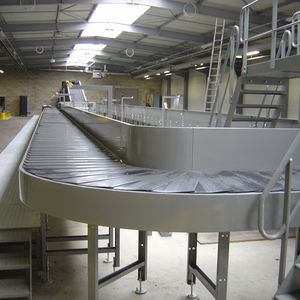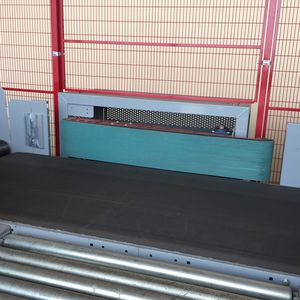
- Company
- Products
- Catalogs
- News & Trends
- Exhibitions
Belt conveyor baggagehorizontalvertical

Add to favorites
Compare this product
Characteristics
- Type
- belt
- Applications
- baggage
- Form
- horizontal, vertical
- Other characteristics
- with scale, automatic
- Domain
- for airport
- Capacity
2,000 p/h
Description
After having been checked-in, bags must be screened using single-view, dual-view, explosive detection (EDS) or tomography X-ray machines, depending on the IATA standard adopted by the airport.
Depending on the number of bags to be handled during peak periods or throughout the year, baggage-handling facilities should be calculated on the basis of T40 (ability to achieve continuous luggage flows apart from during the 40 busiest hours of the year).
Baggage sorting is therefore conducted according to screening status:
Level 0: the bag has not yet been screened
Level 1: the bag has been screened and cleared
Level 2: the bag has been screened and considered suspect
Level 3: the bag has been screened again and cleared
Level 4: the bag has been screened again and considered suspect
Level 1 screening is done either automatically by a machine (standard 3) or by an operator (standard 1 and 2). In case of doubt in standard 3, the machine signals for a human operator, who has a short period of time in which to make a decision. If the operator also has doubts and requests further information, the bag is then rejected to give the operator more time to analyse it.
All these rules and their ever-evolving requirements oblige airport operators to completely rethink their baggage flows.
MATREX help its clients through that process to optimise the cost of investment and the baggage flow to the aeroplane.
We offer automatic baggage-handling solutions of up to 2,000 bags per hour.
Our company can meet the vast majority of needs of regional and international airports on projects with flows not exceeding several million bags per year.
VIDEO
Catalogs
No catalogs are available for this product.
See all of Matrex‘s catalogsExhibitions
Meet this supplier at the following exhibition(s):
Related Searches
- Airport tray return system
- Baggage tray return system
- Horizontal conveyor
- Baggage carousel
- Inclined conveyor
- Roller conveyor
- Horizontal baggage carousel
- Check-in conveyor
- Inclined baggage carousel
- Vertical conveyor
- Conveyor diverter
- Conveyor with scale
- Airport conveyor diverter
- Baggage conveyor diverter
- Scale baggage carousel
- Half moon baggage carousel
- Baggage screening conveyor
- Conveyor with scanner
- Vertical conveyor diverter
- Straight conveyor
*Prices are pre-tax. They exclude delivery charges and customs duties and do not include additional charges for installation or activation options. Prices are indicative only and may vary by country, with changes to the cost of raw materials and exchange rates.




